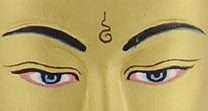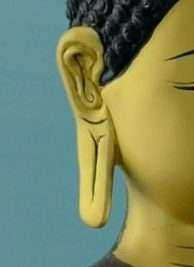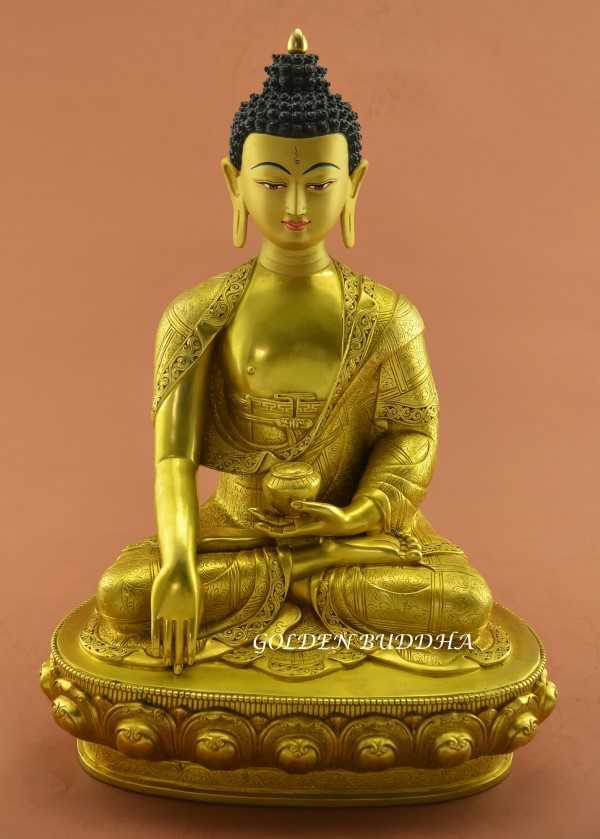The historical Buddha walked the earth long, long ago. Nonetheless, we have a pretty good idea what the Buddha really looked like. In fact, many of the Shakyamuni Buddha statues on this website are accurate depictions of the Buddha. Therefore, features depicted on our statues such as elongated ears, hair in a topknot and golden brown skin tone are indeed accurate.
But how do I know this? You will have to take my word for it unless you continue reading. Follow along and I will help you to form an accurate image of the Buddha, just like the sculptors.
Facts About the Real Buddha:
- A Picture of the Buddha
- The Buddha’s Known Physical Characteristics
- “32” Characteristics of a Great Man
- The Buddha’s Size and Strength
- Was the Buddha Over 6′ Tall?
Ancient Shakyamuni Buddha Statues
Archaeologists trace the origin of Buddha statues to the 2nd century ACE. Previously, statues representing Buddhist artwork focused on a design concept known as “aniconism”. Therefore, prior to this time Buddhist sculpture did not directly feature Shakyamuni Buddha. Instead, typical sculptures of the period featured the Buddha’s footprint, his empty chair or his riderless horse.
We cannot be entirely certain why the Buddhist art of this period excluded accurate depictions of the Buddha. As a result, when sculptors created the first Buddha statues they had to rely on their knowledge of history and descriptions in the Pali Canon.
Sculpture of the Real Buddha
Learn What Buddha Really Looked Like
Nonetheless, it is possible to paint a reasonably accurate portrait of what the Buddha really looked like. This is because some of his more prominent physical characteristics described in the Pali Canon can be cross checked against anthropological evidence from that time period and geographical area. Indeed, many of these characteristics are features found in modern day Shakyamuni Buddha Statues.
- Blue Eyes – The Buddha was born in Northern India in the 6th century BCE into the Shakya Kingdom. Indeed, the Shakya people are described as Indo-Aryan peoples and they were known to have certain Caucasian characteristics such as blue eyes.
- Skin of “Golden Hue” – The Indo-Aryan peoples also had a golden brown skin color as depicted on our best Buddhas. Additionally, the Buddha was born as an elite member of a royal family. As such the royals would have been more likely to have an especially light golden brown skin color compared to dark skin of the commoners.
- Top Knotted Dark Hair – Before renunciation the Buddha had long dark hair and he would have worn what was called an “Ushnisha” topknot. However, after renunciation he wore the shaved head of a monk for the duration of his life.
- Elongated Ears – Royalty in ancient India would have been heavily adorned including ear ornaments. These ornaments in his ears would have stretched his ear lobes quite severely. Therefore, when he completed renunciation and removed all the jewelry he would have been left with stretched earlobes.
- The Buddha was over 6ft Tall – The Buddha was born into a royal family and the historical records of that time period describe some of the Kings in Northern India as being 7ft tall. Thus, we can conclude that as a member of the royal family his height would very likely have been above average.
The Buddha’s Known Physical Characteristics
Before Renunciation (Birth to 29 Years)
With the help of science and cultural history we can generally say the Buddha had blue eyes, long dark hair in a topknot, facial hair (beard), big ears and light golden brown skin. Also, we can conclude he was a tall man and he had well proportioned physical features. Additionally, as a young man before his renunciation he would have worn extravagant amounts of jewelry and fine clothing.
After his renunciation he would have been a figure of austerity wearing a monk’s robes with a shaved head. Also, within the first six years after renunciation he would have appeared very thin and frail from practicing extreme austerity.
However, after he obtained enlightenment at the age of 35, he would have regained his health. But still, he would have worn a shaved head and a monk’s robes.
The “32 Characteristics of a Great Man” found in the Pali Canon are very helpful but they were likely embellished with some metaphysical qualities as well. These embellishments are very helpful in understanding the true meaning of Buddha statues. Read more below about the 32 characteristics physical characteristics described in the Pali Canon.
“32” Characteristics of a Great Man
The Pali Canon is a collection of scriptures which preserve the original teachings of the original Buddha. Fortunately, the Pali Canon includes the “32 Characteristics of a Great Man” and it is supplemented by a list of 80 secondary characteristics. These physical characteristics are widely attributed to the Buddha.
However, the Pali Canon was not immediately committed to writing. As a result, the original Buddhist scriptures continued to be passed on orally for nearly 500 years after the death of Gautama Buddha. Therefore, they were not formally committed to writing until 29 BCE! Nonetheless, from the list of physical characteristics provided we can conclude more or less what the Buddha may have looked like.
The Buddha’s Physical Characteristics
Physical Characteristics List:
Eyes of the Buddha
The eyes of the Buddha were deep blue in color and he had the eyelashes of a “royal bull”. Additionally, the Buddha is described as having a “white uma curl that emits light from between the eyebrows”. This auspicious mark is usually depicted on Shakyamuni Buddha statues as a spiral or circular dot between the eyebrows.

The Buddha was believed to have a whorl of hair between the eyebrows. This is believed to be the sign of penetrating wisdom or a “3rd eye”. The 3rd eye is a sign of a great being or a Buddha. The secondary characteristics tell us his eyebrows were arched like a bow and they reached the outside corners of his eyes. Additionally, his eyebrows had fine hair and the hair lied flat.
The Buddha’s Mouth
The Buddha is described as having the jaw of a lion with 40 white, close and even teeth. He also had 4 pure white canine teeth. His voice is described as “deep and resonant”. It is interesting that his “saliva improved the taste of all food” his tongue was “long and broad”. Furthermore, the secondary characteristics tell us he had fine breath and his mouth had the “scent of a lotus flower”. Additionally, he always wore a beautiful smile.
Buddha’s Hands, Thighs and Feet
The Buddha had a wheel sign on his feet with a thousand spokes. “His fingers and toes were finely webbed, he had level feet, his fingers were long and slender, his hands reached below his knees, he had pliant hands and feet, full sized heels, his instep was arched and he had thighs like a royal stag”.
The Buddha’s Body
The Buddha’s “height and stretch of arms were equal”. Additionally, his body had a “golden hue” and there was a 10 foot aura emanating around him. He had soft smooth skin and the “male organ was well retracted”. His soles, palms, crown of head and shoulders were well rounded. The body was erect and upright and he had “full round” shoulders. The area below his armpits was well filled. Last but not least the Buddha had a “lion shaped body”.
The Buddha’s Hair
The primary characteristics describe his hair roots as dark colored and his bodily hair as graceful and curled. The secondary characteristics go on to describe the tips of his bodily hair as neither curved nor bent. Additionally, his hair is strongly scented like a white lotus, his hair has the color of a dark shadow, it is curled, fine, untangled and does not turn grey. Furthermore, his hair has long curls and the top is knotted as if crowned like a “royal flower garland”.
The description of his hair comes with a bit of controversy. This is because in the Pali Canon there is a phrase attributed to the Buddha that is repeated many times. The phrase describes in the Buddha’s own words how he set out on his quest for enlightenment. The Buddha said that as his parents looked on in tears “I shaved off my hair and beard” and he went forth to begin a homeless life. Therefore, it is most likely that the Buddha would not have had hair on his head or face from that day onward.
The Buddha’s Ears

During the early years of the Buddha’s life he wore large discs in his ear lobes. Therefore, after he completed his renunciation he stopped wearing them and was left with elongated ear lobes. As a result, Buddha statues featuring Shakyamuni Buddha commonly depict him with elongated ear lobes.
It is interesting that in the list of 32 primary characteristics there is no mention of his ears. However, in the list of secondary characteristics his ears are described as “long like lotus petals” with ear holes that are “perfectly rounded”.
The Buddha’s Size and Strength
The list of the Buddha’s physical characteristics indicates that the Buddha may have been physically strong and above average in height. For example the characteristics include:
- That he had the thighs like royal stag
- Hands reaching below his knees
- Lion shaped body
- Jaw like a lion
- Body erect and upright
- Beautiful gait like a king-elephant
- Demeanor of a great man
- Strength of 1,000 crore elephants and 100,000 crore men
- His face is long and beautiful
Was the Buddha Over 6′ Tall?
It is not certain if the Buddha really had such incredible physical strength as “1,000 crore elephants and 100,000 crore men” as it indicates in #8. However, one thing that we do know is that Siddhartha Buddha descended from royal lineage. An important leadership attribute in ancient times is to look stately, which includes a physically imposing body.
Some circumstantial evidence includes historical records from this time period. For example, when Alexander the Great invaded NW India in the 4th century BCE he met fierce opposition from the local kingdoms. One of the Indian kings was described as being a fierce warrior who was 7 feet in height. Therefore, it is very possible that the Buddha may have been over 6 feet tall and had an imperial physical demeanor.



